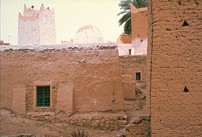|
afrol News, 15 January - By the 1980s, the ancient Libyan oasis town of Ghadamès had become a ghost town after over 2000 years of settlement. The UNESCO World Heritage Site is now in the process of being restored to make it fit for inhabitants to move back again and give new life to the potential tourism resort. Ghadamès is currently seeing a restoration of its buildings and old spring water source, "preserving its heritage and enhancing its appeal to tourists," according to reports by the UN development agency UNDP. Under a UNDP project in cooperation with the Libyan High Authority for Tourism and Antiquities, more than 60 workers are making extensive repairs to adobe buildings in the old town centre, using traditional construction materials. Work has begun on reviving the oasis's Ain al-Faras spring, the UN agency reports. The old town is a UNESCO World Heritage Site, dating back more than 2,000 years to pre-Roman times. Lying behind high defence walls close to what is now the Libya-Tunisia-Algeria tripoint, 640 kilometres south-west of the capital, Tripoli, Ghadamès had always been an important desert trade centre on the caravan routes across the Sahara. Built in an oasis, Ghadamès, "the pearl of the desert", is one of the oldest pre-Roman cities of the northern Sahara and "an outstanding example of a traditional settlement," according to the UNESCO 1986 decision to make it a World Heritage Site. Its architecture is characterised by the different functions assigned to each storey - the ground floor used to store supplies, another floor extending over dark enclosed passages forming a system of passageways, and the open-air terraces were reserved for women. Preservation became a priority when the town began to crumble after its small population moved out in the 1970s and 1980s to live in new homes on an adjacent site, with improved sanitation and modern amenities. Since that, Ghadamès has become a ghost town left to the winds of the Sahara. - The rehabilitation project preserves a valuable piece of Libya's heritage and contributes to local livelihoods in a town with few income sources, the UNDP Office in Libya says. "Many are thus benefiting both from the project and the boost it gives tourism." Local people were reported to have participated in almost every aspect of the project, including technical and architectural studies, restoration work and promoting opportunities for women to produce and sell traditional handicrafts. "The project has helped people develop their skills," said Abdel Baset el-Gaud, the project's technical supervisor. "This is vital for preservation of the old town and it helps people improve their living standards." Mohammed Hasheshi, Ghadamès' former mayor and now the historical consultant for the project, told UNDP the work was "vital" because the old and the new towns needed each other to survive, and tourism would be important to their future. "When the project is finished we will encourage some of the people to return, since the town must be lived in to be preserved and to maintain its interest. But at the same time this must be well managed," he said. Repair and reconstruction had focused on public buildings and old houses, built of bricks, lime, palm tree trunks and fronds. The project has further raised footpaths that serve small fields within the old town oasis, UNDP reports. Workers had used locally quarried gypsum for replastering, and adobe bricks and palm trunks and branches for walls and roofs. The project team further had carried out hydrological and geological studies of the spring to analyse how to rehabilitate it. Over the centuries the people of Ghadamès had developed an intricate network of canals fed by the spring, carrying water throughout the old town and its fields. In the 1980s, after the spring began to dry up, an artesian well was dug to provide water for farmers. "The project aims to revive the spring fully so that it can again feed the oasis and the old town," UNDP said. The old town of Ghadamès already is establishing itself as the main tourist destination in the Libyan desert. A relatively good road connects it with Tripoli and there are at least two buses a day trafficking the 640 kilometres between the capital and Ghadamès, passing via Nalut.
|
front page
| news
| countries
| archive
| currencies
| news alerts login
| about afrol News
| contact
| advertise
| español
©
afrol News.
Reproducing or buying afrol News' articles.
You can contact us at mail@afrol.com

